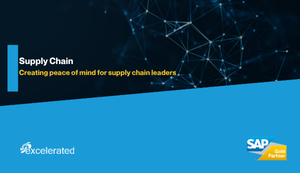The Role of Finance in an End-to-End Procurement Value Chain
How Finance and Procurement Collaboration Drives Shared Business Goals
An automated procure-to-pay (P2P) network that connects buyers and suppliers with a back-end system offers tremendous efficiency gains. One of the most important benefits is the elimination of frustrating delays as emails and faxes of purchase orders, confirmations, and invoices slowly move through the system. This will surprise no one; automated processing and electronic transmissions provide the ability to generate instant answers. Increased efficiency, however, merely scratches the surface of potential benefits when accounts payable (AP) becomes a strategic asset to the company.
When a balance sheet liability (a payable) becomes a strategic asset, the business implications are significant and drive home the reasons why finance organizations are adopting a central role in an extended P2P value chain that connects buyers, suppliers, and partners (such as banking institutions) into a collaborative, connected network. SAP S/4HANA and Ariba Network are helping elevate finance organizations into this role in a fully integrated business network that offers unprecedented spend visibility, supplier management, and contract management, and helps transform day-to-day finance operations.
A fully integrated business network transforms the finance function that until recently had primarily focused its energies on internal process optimization. Hence, it is worthwhile to explore how organizations are capitalizing on the many opportunities that a connected finance organization provides.
Explore related questions
We can break down these opportunities into three pillars that serve as the foundation of SAP’s overall strategy for optimization with SAP S/4HANA and Ariba Network:
- First is the value of the financial supply chain, which is at the core of changing the role of AP from a department mostly responsible for sending checks out the door to one that delivers strategic value through dynamic discounting, supply chain finance, and payment as a means to optimize cash flow.
- Second is the positive change that results by strengthening the collaboration between finance and procurement. When a CFO and CPO get together to optimize the entire procure-to-pay process in a way that benefits the whole company, they can more easily drive efficiency and ensure compliance.
- The third area of opportunity stems from driving efficiency by linking SAP S/4HANA and Ariba Network in a global shared services organization for procurement and environmental issues.
Let’s look at each of these pillars in detail.
Financial Supply Chain
Beyond the elimination of delays and overall greater efficiency from automating invoice approvals in a collaborative network, having instant answers affords AP and accounts receivable (AR) the ability to be proactive. This gets to the core of the financial supply chain opportunity, which is marked by what a finance organization does to capitalize on this newfound ability.
For example, being able to capture and analyze all the data that’s in an invoice and compare it in real time with everything that touches the invoice — such as the contract, purchase order, or service sheet entry form — does far more than just deliver efficiency to the process of approving invoices. Because AP can now capture areas of compliance that otherwise might very easily slip through the cracks, finance can easily ensure that it is not overpaying. The post-audit recovery industry — which exists strictly to re-capture overspending and prevent contract leakage — underscores this concern. Organizations that have to chase after this revenue will not be able to take advantage of volume discounts or have immediate visibility into whether a line item cost on an invoice matched up to the contract price for the specific stock keeping unit (SKU).
For the supplier, the financial supply chain includes the opportunity to optimize cash flow and improve days sales outstanding (DSO). With full visibility into automated invoice payments, AR can more easily explore the financial benefits available either from early payment or, conversely, from holding off until the due date. From the buyer side, finance can work directly with suppliers to accelerate their payment while either maximizing revenue and capturing dynamic discounting opportunities or improving their working capital by maximizing days payable outstanding (DPO).
All of this is predicated on automating the invoice approval process through Ariba Network. And the latest cloud and on-premise releases of SAP S/4HANA now offer native integration with Ariba Network without a separate implementation or add-on, making it easier for customers on this newest release to capture the aforementioned opportunities for cash flow optimizations.
Opportunities in this realm expand with the ability in Ariba Network for finance organizations to tap into an ecosystem of third-party finance providers. For example, one of the leading supply chain finance platform providers, Prime Revenue, is integrated into Ariba Network. This integration includes roughly 60 funding institutions, which buyers and suppliers on Ariba Network can access directly in a single sign-on, single-user experience. What this means is that the global supply chain financing industry is accessible to all participants on Ariba Network.
CFO and CPO Collaboration
One of the developing trends caused by forging an integrated business network is a deeper partnership between CFOs and CPOs as the benefits of supply chain financing take shape (see Figure 1). These line-of-business leaders understand that procurement’s transition into a strategic arm of the business will naturally result in greater collaboration to drive shared business goals. Procurement, then, becomes a key stakeholder in a company’s financial direction.

From a process standpoint, this collaboration means that traditional standalone processes such as source-to-pay or procure-to-pay are instead melded into a holistic, end-to-end procurement process in which finance has complete visibility into the status of a purchase order (PO) or invoice at every stage of its journey. Finance can then use that information to make sure that all the discounts are captured in time, or even profit from additional early discount opportunities.
Procurement as a Shared Service
The shift toward global shared services is not a new phenomenon, of course; large multinationals have been exploring cost savings by transitioning human resources (HR), finance, and IT to a shared service model for many years. Procurement as a shared service, however, is a relatively new concept. Several factors made it a non-starter from an economic standpoint.
A global business network with SAP S/4HANA and Ariba Network eases many of these concerns and helps companies significantly reduce sourcing costs, as well as drive global environmental compliance.
Real Results Today
The opportunities from linking finance to a global business network and extended P2P value chain are being explored by many SAP customers today, with numerous examples of those that are driving real change in how they control spending, collaborate with suppliers, and reduce costs.
A building materials company in the US joined Ariba Network with a stated goal of freeing up procurement to drive strategic buying and capturing discounts by improving straight-through invoice processing. In the first phase of deployment, this company saw an 8% increase (to 67%) in straight-through invoice processing over its legacy system, while also opening a direct line of communication to nearly 1,000 suppliers.
A seafood company in the Philippines leveraged Ariba Network to eliminate manual, paper-based invoices and PO processing, minimize delivery delays, and increase visibility into invoice status. With Ariba helping create an extensive online item catalog that reflects current pricing and specifications, this company saw an 80% reduction in late or overdue payments, a 75% increase in order accuracy, and a 30% reduction in DSO. Similarly, a US retailer chose SAP Ariba solutions for all of its invoice processing and achieved an estimated $4 million-$8 million in annual sourcing cost savings.
With its roots in the procurement side of the ledger, Ariba Network has many customers already driving the full P2P process. What’s interesting is that there are also many SAP customers already using functionality in SAP S/4HANA to drive and keep tabs on cash optimization, dynamic discounting, and the other finance-related implications coming from the procurement side. Many of these customers are now coming into Ariba Network in a kind of reverse scenario, building a business case for invoice process automation as much to forge that collaboration between the CFO and CPO and drive shared business goals as to drive standard efficiency gains.
Yes, automating AP processes and global shared services is a noble goal, but traditionally it has been difficult for standalone AP projects to rise to the top of a company’s priority list from a pure efficiency play. Tack on the ability to turn a balance sheet liability into a strategic asset, however, and suddenly such a business case is not so difficult to make.








